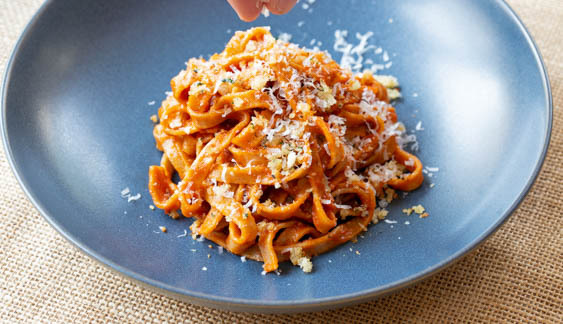Fettuccine Fermentata with Marinara Sauce and Garlicky Bread Crumbs

introduction
Nothing comforts quite like a big bowl of pasta straight off a boil, tossed in red sauce, drifted with freshly fallen Parm, and eaten without witness. Even if conjured from indifferent ingredients, it’s still pretty good. We’re not here to judge.
We will, however, offer a counternarrative: handmade lightly fermented ancient emmer fettuccine with a quick, vibrant red sauce and crisp, garlicky crumbs.
This sauce isn’t trying to hit one out of the park like a pot of bolognese. It doesn’t bother with meat at all. It’s a bright, balanced, and mostly hands-off marinara.
The bread crumbs? They got their own recipe.
Cooking Remarks
Cook times will vary depending on how long the pasta has dried. Fresh pasta (made the same day) needs about 2 minutes in boiling water and overcooks quickly. Pasta that has dried for 24 hours on an open rack in the fridge will take twice as long to cook—4 to 5 minutes. Fully dried pasta may take up to 8 minutes. Irrespective of how long the pasta has dried, make sure to test a noodle now and again while cooking to ensure the pasta is to your liking—then drain and toss it immediately with hot marinara.
equipment mise en place
For this recipe, you will need a large bowl, a 4½- to 5-quart Dutch oven, a blender, a large pot for cooking the pasta, a colander, and warmed serving plates.
-
-
2(28-ounce) cans San Marzano–style tomatoes
-
1cup spring or filtered water
-
½cup extra-virgin olive oil, plus additional for drizzling
-
1large yellow onion, diced large
-
5medium garlic cloves, germ removed if present, chopped
-
2tablespoons chopped fresh oregano
-
1½teaspoons Aleppo pepper or red pepper flakes
-
½cup robust red wine
-
Fine sea salt and freshly ground black pepper
-
12 to 18ounces Fettuccine Fermentata
-
1recipe Garlicky Herbed Bread Crumbs
-
Finely grated Parmesan Reggiano, for serving
-
Fresh basil leaves, whole if small, torn if large, for serving
-
-
Empty the tomatoes and their liquid into a large bowl; set the cans aside. Using your hands, crush the tomatoes (watch out—they spray a bit!) until only small chunks remain. Rinse the tomato cans with the water and add to the tomatoes.
-
In a 4½- to 5-quart Dutch oven, warm the olive oil over medium-low heat. Add the onion and cook, stirring frequently, until softened but without coloring, about 10 minutes. Add the garlic and cook, stirring occasionally, until softened, about 5 minutes. Stir in the oregano and Aleppo pepper, then turn up the heat to medium. Add the wine and simmer until reduced to a glaze. Pour in the tomatoes, stir to combine, and bring to a simmer. Turn down the heat to medium-low and cook uncovered, stirring occasionally, until the mixture is jammy in consistency and deep red in color, about 1½ hours.
-
Transfer the tomato mixture to a blender and add 2 teaspoons salt; reserve the pot. Blend on medium speed until smooth, then return the sauce to the pot. Taste for seasoning and add more salt, if desired. Cover to keep warm while you cook the pasta.
-
Bring a large pot of water to a rolling boil over high heat and season lightly with salt. Place a colander in the sink. Drop the pasta into the boiling water and stir with a fork to ensure the noodles do not stick to the pot or to each other. Return to a boil, turn down the heat to medium-high, and simmer until the pasta is tender, 2 to 8 minutes, depending on how long the pasta has dried (see Cooking Remarks); make sure intermittently to test the noodles for doneness.
-
As soon as the pasta is done, drain it in the colander; reserve the pot. Drizzle lightly with olive oil and toss. Return the pasta to the pot, add the amount of warm sauce that suits you, and toss to combine. Pile onto warmed serving plates and garnish with bread crumbs, a generous dusting of Parmesan, and a few basil leaves.
recipe by Henry Jones